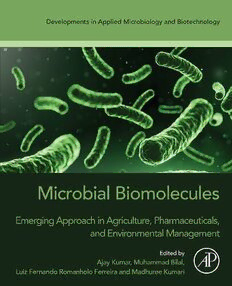
Microbial Biomolecules: Emerging Approach in Agriculture, Pharmaceuticals and Environment Management PDF
Preview Microbial Biomolecules: Emerging Approach in Agriculture, Pharmaceuticals and Environment Management
Microbial Biomolecules This pageintentionallyleftblank Developments in Applied Microbiology and Biotechnology Microbial Biomolecules Emerging Approach in Agriculture, Pharmaceuticals, and Environmental Management Edited by Ajay Kumar Department of Postharvest Science, Agriculture Research Organization, Volcani Center, Rishon LeZion, Israel Muhammad Bilal Institute of Chemical Technology and Engineering, Faculty of Chemical Technology, Poznan University of Technology, Poznan, Poland Luiz Fernando Romanholo Ferreira Graduate Program in Process Engineering, Tiradentes University, Aracaju, SE, Brazil; Institute of Technology and Research, Aracaju, SE, Brazil Madhuree Kumari Indian Institute of Science, Bengaluru, Karnataka, India AcademicPressisanimprintofElsevier 125LondonWall,LondonEC2Y5AS,UnitedKingdom 525BStreet,Suite1650,SanDiego,CA92101,UnitedStates 50HampshireStreet,5thFloor,Cambridge,MA02139,UnitedStates TheBoulevard,LangfordLane,Kidlington,OxfordOX51GB,UnitedKingdom Copyright©2023ElsevierInc.Allrightsreserved. Nopartofthispublicationmaybereproducedortransmittedinanyformorbyanymeans,electronicormechanical, includingphotocopying,recording,oranyinformationstorageandretrievalsystem,withoutpermissioninwritingfromthe publisher.Detailsonhowtoseekpermission,furtherinformationaboutthePublisher’spermissionspoliciesandour arrangementswithorganizationssuchastheCopyrightClearanceCenterandtheCopyrightLicensingAgency,canbefound atourwebsite:www.elsevier.com/permissions. ThisbookandtheindividualcontributionscontainedinitareprotectedundercopyrightbythePublisher(otherthanasmay benotedherein). Notices Knowledgeandbestpracticeinthisfieldareconstantlychanging.Asnewresearchandexperiencebroadenour understanding,changesinresearchmethods,professionalpractices,ormedicaltreatmentmaybecomenecessary. Practitionersandresearchersmustalwaysrelyontheirownexperienceandknowledgeinevaluatingandusingany information,methods,compounds,orexperimentsdescribedherein.Inusingsuchinformationormethodstheyshouldbe mindfuloftheirownsafetyandthesafetyofothers,includingpartiesforwhomtheyhaveaprofessionalresponsibility. Tothefullestextentofthelaw,neitherthePublishernortheauthors,contributors,oreditors,assumeanyliabilityforany injuryand/ordamagetopersonsorpropertyasamatterofproductsliability,negligenceorotherwise,orfromanyuseor operationofanymethods,products,instructions,orideascontainedinthematerialherein. ISBN:978-0-323-99476-7 ForInformationonallAcademicPresspublications visitourwebsiteathttps://www.elsevier.com/books-and-journals Publisher:StacyMasucci AcquisitionsEditor:KattieWashington EditorialProjectManager:RonaldoMeris ProductionProjectManager:MariaBernard CoverDesigner:GregHarris TypesetbyMPSLimited,Chennai,India Contents List of contributors...............................................................................................xix Chapter 1:Rhizobacterial biomolecules for sustainable crop production and environmental management: plausible functions and molecular mechanisms.......................................................................................... 1 B.N. Aloo, B.O. Nyongesa, J.O.Were,B.A.WereandJ.B. Tumuhairwe 1.1 Introduction...........................................................................................................1 1.2 Types and functions of rhizobacterial biomolecules...............................................2 1.2.1 Enzymes.....................................................................................................2 1.2.2 Plant growth-promoting hormones..............................................................4 1.2.3 Siderophores...............................................................................................9 1.2.4 Volatile organic compounds......................................................................12 1.2.5 Organic acids............................................................................................15 1.2.6 Antibiotics................................................................................................16 1.3 Emerging gaps and perspectives..........................................................................18 1.4 Concluding remarks.............................................................................................19 References...................................................................................................................20 Chapter 2:Microbial biomolecules: reducing viral loads in agriculture..................... 31 Taruna Gupta, Tripti Singhaland Ashish Srivastava 2.1 Introduction.........................................................................................................31 2.2 Virus impact on plants and economy...................................................................32 2.3 Plant growth-promoting rhizobacteria—the redeemer of plants...........................33 2.4 Nutrients availability by plant growth-promoting rhizobacteria for plants............34 2.5 Plant growth-promoting rhizobacteria itself as a biofertilizer...............................35 2.6 Strains of plant growth-promoting rhizobacteria play a role in empowering plants to fight against virus stress........................................................................35 2.7 Conclusion...........................................................................................................36 v vi Contents Conflict of interest.......................................................................................................37 Acknowledgment.........................................................................................................37 References...................................................................................................................37 Chapter 3:Quorum quenching in marine bacteria and its applications .................... 43 S.V. Sandhya 3.1 Quorum quenching..............................................................................................44 3.2 Quorum quenching in marine bacteria.................................................................45 3.3 Applications of quorum quenching......................................................................47 3.4 Future perspectives..............................................................................................49 Acknowledgments........................................................................................................49 References...................................................................................................................49 Chapter 4:Microbially synthesized nanoparticles: application in health-care management....................................................................................... 53 Sidra Salam, Nida Khaliq, Nazim Hussain, ZulqarnainBaqar, Hafiz M.N. Iqbal and Muhammad Bilal 4.1 Introduction.......................................................................................................53 4.2 Characteristics of nanoparticles..........................................................................54 4.3 Classification of nanoparticles...........................................................................54 4.4 Intracellular synthesis of nanoparticles by bacteria............................................55 4.5 Extracellular synthesis of nanoparticles by bacteria...........................................56 4.6 Virus-mediated biosynthesis of nanoparticles.....................................................56 4.7 Metallic nanoparticles........................................................................................58 4.7.1 Gold nanoparticles..................................................................................58 4.7.2 Silver nanoparticles.................................................................................59 4.7.3 Alloy nanoparticles.................................................................................59 4.7.4 Other metallic nanoparticles....................................................................59 4.8 Oxide nanoparticles...........................................................................................60 4.8.1 Magnetic oxide nanoparticles..................................................................60 4.8.2 Nonmagnetic oxide nanoparticles...........................................................61 4.9 Sulfide nanoparticles..........................................................................................62 4.10 Mechanisms of nanoparticle formation by microorganisms................................63 4.11 Control of size and morphology of nanoparticles...............................................64 4.12 Applications of nanoparticles.............................................................................67 4.12.1 Nanomedicine.......................................................................................67 4.12.2 Drug delivery........................................................................................67 4.12.3 Antibacterial agent................................................................................70 Contents vii 4.12.4 Biosensor..............................................................................................70 4.12.5 Reaction rate enhancement agent..........................................................71 4.12.6 Magnetic separation and detection........................................................71 4.12.7 In diagnostics........................................................................................72 4.13 Conclusion.........................................................................................................72 4.14 Future prospects.................................................................................................73 References...................................................................................................................74 Chapter 5:Microbial biofilm approaches in phytopathogen management................. 77 Pratibha Verma, PriyankaChauhan, Navinit Kumar, Nishtha Mishra, Shipra Pandey, RamakantBajpai, Jay Kumar Yadav, Ratna Sahay,Lal Bahadur andAradhanaMishra 5.1 Introduction.........................................................................................................77 5.2 Role of microbial species in biofilm formation....................................................79 5.3 Mechanism of biofilm formation.........................................................................80 5.3.1 Initial attachment of microbial cells to the surface....................................81 5.3.2 Irreversible attachment..............................................................................81 5.3.3 Colony formation......................................................................................82 5.3.4 Maturation................................................................................................82 5.3.5 Detachment...............................................................................................82 5.4 Limiting factor for biofilm formation..................................................................82 5.5 The molecular mechanism involved in biofilm formation....................................83 5.6 Phytopathogen management approaches through biofilm.....................................85 5.6.1 Cross talk between pathogenic and beneficial microbes with plants..........87 5.6.2 Role of biofilm as in biocontrol................................................................88 5.6.3 Role of biofilms in mitigating stress.........................................................89 5.6.4 Microbial approaches in the agriculture sector..........................................89 5.7 Conclusion and future prospective.......................................................................90 References...................................................................................................................91 Chapter 6:Health benefits of bacteriocins produced by probiotic lactic acid bacteria....................................................................................... 97 Pushpa Rani and SantoshKumar Tiwari 6.1 Introduction.......................................................................................................97 6.2 Bacteriocins.......................................................................................................98 6.3 Mode of action of bacteriocins...........................................................................99 6.4 Modulation of gut microbiota, immune modulation, and anti-inflammation activity.............................................................................................................100 6.5 Antioxidant activity.........................................................................................101 viii Contents 6.6 Antibiofilm activity..........................................................................................102 6.7 Application of bacteriocins in a few important human diseases.......................102 6.7.1 Antibiotic-associated diarrhea...............................................................102 6.8 Inflammatory bowel disease.............................................................................103 6.9 Cancer.............................................................................................................103 6.10 Obesity............................................................................................................104 6.11 Diabetes...........................................................................................................105 6.12 Urinary tract infection......................................................................................105 6.13 Summary.........................................................................................................107 References.................................................................................................................108 Further reading...........................................................................................................111 Chapter 7: Actinomycetes, cyanobacteria, and fungi: a rich source of bioactive molecules...........................................................................................113 Areej Shahbaz, Nazim Hussain, Syeda Saba and MuhammadBilal 7.1 Introduction.......................................................................................................113 7.2 Actinomycetes: biology and bioactive compounds..............................................116 7.3 Mechanism of production of bioactive compounds by actinomycetes................117 7.4 Cyanobacteria: biology and bioactive compounds.............................................118 7.5 Mechanism of production of bioactive compounds by cyanobacteria.................119 7.6 Fungi: biology and bioactive compounds...........................................................120 7.7 Mechanism of production of bioactive compounds by fungi..............................121 7.8 Applications of bioactive compounds of actinomycetes, cyanobacteria, and fungi............................................................................................................121 7.8.1 Production of antibiotics.........................................................................121 7.8.2 Antiviral agents.......................................................................................122 7.8.3 Antitumor compounds.............................................................................122 7.8.4 Production of pigments...........................................................................123 7.8.5 Biopesticide agents.................................................................................124 7.8.6 Antiinflammatory compounds.................................................................125 7.8.7 Biosurfactant...........................................................................................125 7.8.8 Some specified applications....................................................................126 7.9 Conclusion.........................................................................................................127 References.................................................................................................................127 Chapter 8:Bioactive compounds from endophytic microorganisms..........................135 Ragini G.Bodade 8.1 Introduction.....................................................................................................135 Contents ix 8.2 Isolation, enrichment, purification, and characterization of endophytes for bioactive compounds..................................................................................136 8.3 Antibacterial and antifungal compounds from endophytes...............................137 8.4 Antiviral compounds from endophytes.............................................................141 8.5 Antiinflammatory compounds from endophytes...............................................143 8.6 Enzyme-inhibitory activity of compounds from endophytes............................144 8.7 Antimycobacterial compounds from endophyte...............................................145 8.8 Antidiabetic compounds from endophytes.......................................................146 8.9 Anticancer compounds from endophytes..........................................................148 8.10 Antioxidant compounds from endophytes........................................................150 8.11 Conclusion.......................................................................................................151 Acknowledgments......................................................................................................152 Conflict of interest.....................................................................................................152 References.................................................................................................................152 Chapter 9:Microbial metabolites in plant disease management.............................159 Ritu Dixit andMadhuree Kumari 9.1 Introduction.......................................................................................................159 9.2 Secondary metabolites.......................................................................................160 9.2.1 Bacterial secondary metabolites..............................................................161 9.2.2 Fungal secondary metabolites.................................................................164 9.2.3 Secondary metabolites from actinomycetes.............................................166 9.3 Endophytes........................................................................................................168 9.4 A new source of microbial metabolites for plant disease management..............169 9.5 Challenges and future perspectives....................................................................172 9.5.1 Increase in yield of microbial metabolites...............................................172 9.5.2 Sustained release and low cost................................................................172 9.5.3 Environmental safety and toxicological assessment................................173 9.5.4 Academics and industrial collaborations.................................................173 9.6 Conclusions.......................................................................................................173 Acknowledgment.......................................................................................................174 References.................................................................................................................174 Chapter 10: Secondary metabolites from marine fungi: current status and application...............................................................................181 Siya Kamat,Sahana Kumar, SarahPhilip and Madhuree Kumari 10.1 Introduction.....................................................................................................181 10.1.1 Polyketides..........................................................................................182
